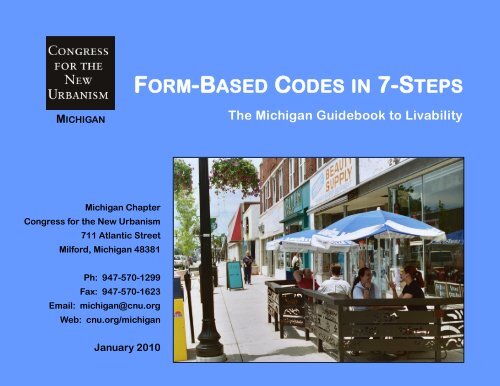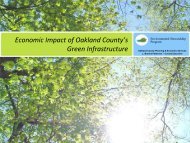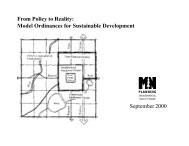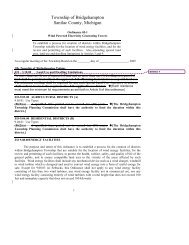FORM-BASED CODES IN 7-STEPS - Michigan Society of Planning
FORM-BASED CODES IN 7-STEPS - Michigan Society of Planning
FORM-BASED CODES IN 7-STEPS - Michigan Society of Planning
Create successful ePaper yourself
Turn your PDF publications into a flip-book with our unique Google optimized e-Paper software.
<strong>FORM</strong>-<strong>BASED</strong> <strong>CODES</strong> <strong>IN</strong> 7-<strong>STEPS</strong><br />
MICHIGAN<br />
The <strong>Michigan</strong> Guidebook to Livability<br />
<strong>Michigan</strong> Chapter<br />
Congress for the New Urbanism<br />
711 Atlantic Street<br />
Milford, <strong>Michigan</strong> 48381<br />
Ph: 947-570-1299<br />
Fax: 947-570-1623<br />
Email: michigan@cnu.org<br />
Web: cnu.org/michigan<br />
January 2010
<strong>Michigan</strong> Chapter<br />
Congress for the New Urbanism<br />
<strong>FORM</strong>-<strong>BASED</strong> <strong>CODES</strong> <strong>IN</strong> 7-<strong>STEPS</strong><br />
The <strong>Michigan</strong> Guidebook to Livability<br />
WRITTEN BY MEMBERS OF CNU MICHIGAN<br />
Leslie E. Kettren, AICP, PCP<br />
Editor and Principal Author<br />
Christina Anderson, AICP<br />
James Bedell, AICP<br />
Michael Campbell, AIA<br />
H. William Freeman, JD<br />
Jay Hoekstra, AICP<br />
Philip L. Meyer, AICP<br />
Copyright © 2010 by CNU <strong>Michigan</strong>, Inc.<br />
All rights reserved. No part <strong>of</strong> this publication may be reproduced or<br />
transmitted in any form or by any means, electronic, or mechanical,<br />
including photocopying, recording, or any other information storage<br />
and retrieval system, without written permission . Contact CNU<br />
<strong>Michigan</strong>, Inc. at michigan@cnu.org .<br />
Acknowledgments<br />
We wish to thank the members <strong>of</strong> the CNU <strong>Michigan</strong> Chapter<br />
and our continuing collaborators: The <strong>Michigan</strong> Municipal<br />
League, the <strong>Michigan</strong> Chapter <strong>of</strong> the American <strong>Planning</strong><br />
Association, the <strong>Michigan</strong> State Housing Development<br />
Authority, The Form-Based Code Institute, and the National<br />
Charrette Institute for their inspiration and ways to improve<br />
the FBC guidebook.<br />
Jasneet Sharma<br />
James Breuckman<br />
Sherrin Hood<br />
Jeff Purdy<br />
Lynn Wilson<br />
John Jackson<br />
Zachary Branigan<br />
Daniel J. Strikwerda<br />
Rod Arroyo<br />
Andrea Brown<br />
Aarin Lutzenhiser<br />
Ge<strong>of</strong>f Ferrell<br />
Rebecca Bessey<br />
Robert Gibbs<br />
Katherine Wyrosdick<br />
Brad Strader<br />
Chris Doozan<br />
Valdis Lazdins<br />
Lynee Wells<br />
Josh Long<br />
Rick Bernhardt<br />
Arnold Weinfeld<br />
Bill Lennertz<br />
Mary Fadden<br />
Carol Wyant<br />
2 Form-Based Codes in 7-Steps
<strong>Michigan</strong> Chapter<br />
Congress for the New Urbanism<br />
CNU <strong>Michigan</strong><br />
<strong>Michigan</strong> Chapter <strong>of</strong> Congress for the New Urbanism<br />
Board <strong>of</strong> Directors<br />
Leslie E. Kettren, AICP, PCP<br />
President<br />
Terry Sanford<br />
Vice President<br />
James Bedell, AICP<br />
Secretary<br />
H. William Freeman, JD<br />
Treasurer<br />
Directors<br />
Christina K. Anderson, AICP<br />
Douglas J. Atkinson, AIA<br />
Robert J. Gibbs, ASLA, CNU<br />
Jay Hoekstra, AICP<br />
Philip L. Meyer, AICP<br />
Leslie Sickterman, AICP, PCP<br />
James Tischler, AICP, PCP<br />
Lynn Wilson, AICP<br />
Mission<br />
CNU <strong>Michigan</strong> is organized exclusively for<br />
educational purposes. Our mission is to:<br />
Organize and produce meetings and<br />
conferences dedicated to the refinement and<br />
dissemination <strong>of</strong> the principles and<br />
techniques <strong>of</strong> New Urbanism<br />
Produce and distribute written<br />
documents and audio visual materials for<br />
the purpose <strong>of</strong> educating the public and<br />
planning pr<strong>of</strong>ession<br />
Further advance the principles <strong>of</strong><br />
New Urbanism through networking and<br />
publicity avenues<br />
Advisory Board<br />
Rick Ballard, <strong>Michigan</strong> State Housing Development Authority<br />
Andrea Brown, <strong>Michigan</strong> Association <strong>of</strong> <strong>Planning</strong><br />
Arnold Weinfeld, <strong>Michigan</strong> Municipal League<br />
Form-Based Codes in 7-Steps 3
<strong>Michigan</strong> Chapter<br />
Congress for the New Urbanism<br />
CONTENTS<br />
PAGE<br />
PART 1 SETT<strong>IN</strong>G THE STAGE ................................................ 8<br />
Introduction ........................................................................ 9<br />
Background .................................................................. 9<br />
Why Write this Guidebook? ......................................... 9<br />
What is the Purpose <strong>of</strong> the FBC Guidebook? ............. 11<br />
What is a FBC? ............................................................ 12<br />
How do FBCs Differ from Conventional ....................... 12<br />
Zoning Codes?<br />
Historic Preservation & FBCs ...................................... 13<br />
FBCs in the Suburbs .................................................... 13<br />
Resource Information ................................................... 14<br />
Are FBCs Legal in <strong>Michigan</strong>? ...................................... 14<br />
What is in the Guidebook? ........................................... 14<br />
Step 1 Community Intentions............................................ 16<br />
Introduction .................................................................. 16<br />
Questions to Help Determine Your Intentions ............. 16<br />
Principles <strong>of</strong> Urban Design .......................................... 18<br />
What Effort Can your Community Support? ................ 21<br />
Step 2 Finance .................................................................. 22<br />
Introduction .................................................................. 22<br />
Questions to Ask Yourself ........................................... 22<br />
What does the FBC Cost? ........................................... 24<br />
Step 3 Getting the Right People ....................................... 25<br />
Introduction .................................................................. 25<br />
Two Approaches .......................................................... 25<br />
Develop an Action Plan ............................................... 30<br />
Who are the Leaders? ................................................. 31<br />
Tips to Inform the Public .............................................. 33<br />
PAGE<br />
Step 3 (con’t)<br />
Tips to Get & Keep People Involved........................... 34<br />
Final Words <strong>of</strong> Wisdom ............................................... 37<br />
Step 4 Community Scoping ............................................. 38<br />
Where Should the FBC apply? ................................... 38<br />
What are the Existing Conditions? ............................. 38<br />
Community Site Visit ................................................... 39<br />
Observations for “Greenfield” and .............................. 40<br />
Undeveloped Sites<br />
Step 5 Community Visioning............................................ 43<br />
Introduction ................................................................. 43<br />
Multi-Day Charrette Process....................................... 43<br />
Cost Saving Measures ................................................ 46<br />
Other Tools and Techniques ...................................... 46<br />
PART 2 DRAFT<strong>IN</strong>G THE CODE .............................................. 50<br />
Step 6 - Writing the FBC ......................................................... 51<br />
Introduction ....................................................................... 51<br />
Gather Developed Information ......................................... 51<br />
FBC Basic Components ................................................... 51<br />
Organizing Your FBC .............................................................. 53<br />
Organize Within the Municipal Code Structure ................ 53<br />
Determine the Right Code ................................................ 54<br />
Determine the Right Organizing Method .......................... 56<br />
Create the Regulating Plan ............................................... 62<br />
Building Form Standards ........................................................ 64<br />
Introduction ....................................................................... 64<br />
Building Placement ........................................................... 64<br />
4 Form-Based Codes in 7-Steps
<strong>Michigan</strong> Chapter<br />
Congress for the New Urbanism<br />
CONTENTS<br />
PAGE<br />
Building Standards ..................................................................... 68<br />
Placement & Form ................................................................ 68<br />
Building Height ..................................................................... 68<br />
Windows ............................................................................... 72<br />
Entrances & Doors ............................................................... 72<br />
Ro<strong>of</strong>s .................................................................................... 74<br />
Private Frontages ................................................................. 75<br />
Public Space Standards ............................................................. 77<br />
Introduction ........................................................................... 77<br />
Components <strong>of</strong> Street Standards ......................................... 77<br />
Create Street Sections ......................................................... 79<br />
Land Use .................................................................................... 82<br />
Introduction ........................................................................... 82<br />
Use Categories ..................................................................... 82<br />
Subdivision Regulations ............................................................. 85<br />
Introduction ........................................................................... 85<br />
Unified Development Ordinance .......................................... 86<br />
Blocks, Lots and streets ....................................................... 86<br />
Sustainable Development .......................................................... 87<br />
Subdivision Regs .................................................................. 87<br />
LEED .................................................................................... 87<br />
Parks & Open Spaces ................................................................ 89<br />
Optional FBC Components ........................................................ 91<br />
Introduction ........................................................................... 91<br />
Walls and Fences ................................................................. 91<br />
Other Landscaping Elements ............................................... 92<br />
Building Signage .................................................................. 92<br />
PAGE<br />
Lighting.............................................................................. 94<br />
Mechanical, Waste & Loading .......................................... 94<br />
Natural & Sustainable Materials ....................................... 95<br />
PART 3 ADM<strong>IN</strong>ISTRATION ..................................................... 97<br />
Step 7 Code Adoption & Administration ................................ 98<br />
Introduction ....................................................................... 98<br />
Road Test ......................................................................... 98<br />
Chick or Egg—What comes first? .................................... 99<br />
Master Plan Review and Update ...................................... 99<br />
Map Amendments ............................................................. 101<br />
<strong>Michigan</strong> Laws .................................................................. 101<br />
Test Amendments ............................................................. 101<br />
Putting it all Together ........................................................ 104<br />
Last Steps ............................................................................... 106<br />
Rolling Out the FBC .......................................................... 106<br />
Review & Refinement ....................................................... 106<br />
Conclusion ........................................................................ 107<br />
APPENDICES .................................................................................... 108<br />
Frequently Asked Questions .................................................... 109<br />
Regulations .............................................................................. 112<br />
Legal Basis for FBCs ......................................................... 112<br />
Mandatory & Parallel FBCs ............................................... 114<br />
Charter <strong>of</strong> the New Urbanism ................................................... 115<br />
Field Exercise ........................................................................... 119<br />
Site Visits ........................................................................... 119<br />
Field Exercise Instructions ................................................. 119<br />
Example—How to Observe Building Height ...................... 120<br />
Form-Based Codes in 7-Steps 5
<strong>Michigan</strong> Chapter<br />
Congress for the New Urbanism<br />
CONTENTS<br />
PAGE<br />
APPENDICES (con’t)<br />
FBC Formatting ............................................................................. 130<br />
Formatting Tips ...................................................................... 130<br />
The Birmingham Example ............................................................. 133<br />
Project Summary .................................................................... 133<br />
2016 Plan ............................................................................... 135<br />
Transferability ......................................................................... 136<br />
Quality .................................................................................... 136<br />
Comprehensive ...................................................................... 136<br />
Role <strong>of</strong> Planners ..................................................................... 138<br />
Implementation Strategy......................................................... 138<br />
Effectiveness and Results ...................................................... 138<br />
<strong>IN</strong>DEX ................................................................................................... 140<br />
FIGURES ............................................................................................... 143<br />
MAPS<br />
Birmingham Triangle District FBC .................................................. 54<br />
Transect/Zone Based Regulating Plan ........................................... 60<br />
Building Type and Transect Zone Regulating Plan ......................... 61<br />
Frontage-Based Regulating Plan .................................................... 61<br />
Understanding the Regulating Plan(2) ............................................ 63<br />
PHOTOGRAPHS<br />
Downtown Ferndale<br />
Cover<br />
Courtesy <strong>of</strong> Leslie E Kettren<br />
City <strong>of</strong> Hazel Park (2).................................................................... 10<br />
City <strong>of</strong> Bay City (2)........................................................................ 11<br />
Village <strong>of</strong> Lake Isabella (2)............................................................ 11<br />
Staff taking notes 26, 28<br />
PAGE<br />
PHOTOGRAPHS (con’t)<br />
City <strong>of</strong> Detroit, “Box City” event .................................................. 34<br />
City <strong>of</strong> Alma (2)…………………………………….. ...................... 35<br />
City <strong>of</strong> Hazel Park (2)……………………………….. .................... 40<br />
City <strong>of</strong> Ferndale……………………………………….. .................. 41<br />
City <strong>of</strong> Monroe…………………….………….. .............................. 41<br />
City <strong>of</strong> Alma (photo enhanced)………….…….. .......................... 42<br />
City <strong>of</strong> Allegan……………………………………….. .................... 49<br />
City <strong>of</strong> Northville (2)……………………………… ......................... 69<br />
Shelby Township (2) ....................................................................69<br />
Demonstration <strong>of</strong> Measuring Building Heights .............................70<br />
City <strong>of</strong> Birmingham .......................................................................72<br />
City <strong>of</strong> Ferndale ............................................................................74<br />
City <strong>of</strong> Brighton ............................................................................74<br />
City <strong>of</strong> Grand Rapids ....................................................................77<br />
City <strong>of</strong> Ann Arbor ..........................................................................77<br />
City <strong>of</strong> East Lansing .....................................................................89<br />
Painted Wall Signs (2) .................................................................92<br />
Sandwich Board Sign ...................................................................92<br />
4-Story Measurement ................................................................ 121<br />
City <strong>of</strong> Birmingham (6) .................................. 133,135,136,137,139<br />
SIDEBARS<br />
FBCs Differ from Conventional Zoning ..........................................12<br />
7-Steps <strong>of</strong> FBC Guidebook ............................................................15<br />
Principles <strong>of</strong> Good Urban Design ..................................................17<br />
Do You Have a Vision? .................................................................19<br />
Have You Done Your Homework? .................................................20<br />
What is Design-Based <strong>Planning</strong> ....................................................21<br />
Approach #1: Have Money—Have Resources .............................26<br />
Approach #1: Responsibilities ......................................................27<br />
6 Form-Based Codes in 7-Steps
<strong>Michigan</strong> Chapter<br />
Congress for the New Urbanism<br />
CONTENTS<br />
PAGE<br />
SIDEBARS (con’t)<br />
Approach #2: Have Some Money—Have Some Resources ........ 28<br />
Approach #2: Responsibilities ..................................................... 29<br />
Get the Right People .................................................................... 30<br />
Ways to Involve & Inform the Public ............................................. 33<br />
Ground Rules for Committee Meetings ......................................... 36<br />
Observe Existing Conditions (Building Form) ............................... 41<br />
Observe Existing Conditions (Public Space & Streets) ................. 42<br />
Multi-Day Charrette Plan Schedule............................................... 44<br />
A FBC Working Outline ................................................................. 51<br />
Basic Components........................................................................ 52<br />
Determine the Right FBC Organizing Method .............................. 56<br />
What is the SmartCode? ............................................................... 58<br />
Comparison <strong>of</strong> Two CVS Stores ................................................... 69<br />
Common Types <strong>of</strong> Buildings in <strong>Michigan</strong> ...................................... 71<br />
Transit Oriented Development Activity Nodes .............................. 80<br />
Common Use Categories ............................................................. 83<br />
Materials to Use for Trim .............................................................. 96<br />
Check List #1 ................................................................................ 98<br />
Master Plan Supportive Goals ...................................................... 99<br />
Check List #2 ............................................................................... 100<br />
Know Your Enabling Legislation .................................................. 101<br />
Check List #3 ............................................................................... 102<br />
Check List #4 ............................................................................... 102<br />
Process for Amendments and Rezoning ..................................... 103<br />
Check List #5 ............................................................................... 104<br />
Model Process for Administration <strong>of</strong> the FBC .............................. 105<br />
The Region: Metropolis, City and Town ...................................... 116<br />
The Neighborhood, the District and the Corridor ......................... 117<br />
The Block, the Street and the Building ......................................... 118<br />
Fonts ............................................................................................ 130<br />
PAGE<br />
SIDEBARS (con’t)<br />
Condensed Type ............................................................................ 131<br />
All Caps .......................................................................................... 131<br />
Page Elements ............................................................................... 131<br />
TABLES<br />
Summary <strong>of</strong> Methods for Organizing Your FBC .............................. 57<br />
Use Table........................................................................................ 84<br />
WORKSHEETS<br />
Elements & Use .............................................................................. 122<br />
Height, Pr<strong>of</strong>ile & Lot Siting .............................................................. 124<br />
Public Space & Streets ................................................................... 126<br />
Form-Based Codes in 7-Steps 7
<strong>Michigan</strong> Chapter<br />
Congress for the New Urbanism<br />
PART 1<br />
SETT<strong>IN</strong>G THE STAGE<br />
8 Form-Based Codes in 7-Steps
<strong>Michigan</strong> Chapter<br />
Congress for the New Urbanism<br />
Introduction<br />
BACKGROUND<br />
It is widely recognized that <strong>Michigan</strong><br />
needs zoning reform. The built and<br />
natural environments demand it, and<br />
so do the demographics and markets.<br />
Zoning codes that have been adopted<br />
in the last 60 years strongly favor<br />
spread-out single-use development.<br />
This trend <strong>of</strong> minimum lot sizes,<br />
minimum building setbacks, parking<br />
requirements, street width standards,<br />
and restrictions that separate uses has<br />
lead to sprawl in our state and across<br />
the country.<br />
Hardly anyone defends conventional<br />
codes anymore at pr<strong>of</strong>essional<br />
conferences or in publications – yet<br />
they persist. Conventional zoning is<br />
very difficult to change because the<br />
status quo is so powerful. Zoning has<br />
made the public wary <strong>of</strong> new<br />
development because it continually<br />
produces low quality development, and<br />
unfortunately, conventional zoning<br />
does not encourage walking or<br />
alternative forms <strong>of</strong> transportation or<br />
add to cultural, social and<br />
entertainment <strong>of</strong>ferings in a way that<br />
maximizes and improves quality <strong>of</strong> life.<br />
WHY WRITE THIS GUIDEBOOK?<br />
The <strong>Michigan</strong> Chapter <strong>of</strong> Congress<br />
for the New Urbanism (MiCNU) is<br />
committed to stopping sprawl and reestablishing<br />
compact, walkable and<br />
environmentally sustainable cities,<br />
villages and neighborhoods. Changing<br />
the way communities currently do<br />
zoning in <strong>Michigan</strong> has been identified<br />
as the major hurdle in reaching our<br />
mission.<br />
After careful research and<br />
development by the Congress for the<br />
New Urbanism (CNU) and the Form-<br />
Based Code Institute (FBCI), Form-<br />
Based Codes (FBCs) have come to the<br />
forefront as the most effective method<br />
to accomplish zoning reform in<br />
<strong>Michigan</strong>. To that end, MiCNU has<br />
developed three (3)-implementation<br />
steps.<br />
Step 1 - FBC Training First, MiCNU<br />
has already begun the process <strong>of</strong><br />
informing people about FBCs. MiCNU<br />
partnered with the <strong>Michigan</strong><br />
Municipal League and the <strong>Michigan</strong><br />
Chapter <strong>of</strong> the American <strong>Planning</strong><br />
Association to <strong>of</strong>fer educational<br />
workshops. These were held in<br />
February, April, May and July 2009.<br />
As a result, more than 60 people have<br />
graduated with Form-Based Code<br />
certificates <strong>of</strong> course completion.<br />
Step 2 - FBC Guidebook Project.<br />
MiCNU recognized that workshops<br />
alone would not be enough to create<br />
Form-Based Codes in 7-Steps 9
<strong>Michigan</strong> Chapter<br />
Congress for the New Urbanism<br />
the kind <strong>of</strong> change that is hoped for in<br />
<strong>Michigan</strong>. Therefore, seven (7)<br />
members <strong>of</strong> MiCNU have written this<br />
guidebook.<br />
The guidebook simplifies FBCs and<br />
removes the mystique associated with<br />
them. Specific to <strong>Michigan</strong> (and the<br />
first <strong>of</strong> its kind anywhere in the<br />
nation), the guidebook is a step-by-step<br />
process that explains what<br />
communities need to know, helps them<br />
decide what to do, and leads them<br />
through the process <strong>of</strong> how a FBC is<br />
written, adopted and implemented.<br />
Site Visits. In addition, the MiCNU<br />
organization knows that receiving the<br />
guidebook is not enough to really<br />
understand the process <strong>of</strong><br />
implementing a FBC. Therefore as a<br />
part <strong>of</strong> the FBC Guidebook Project,<br />
members <strong>of</strong> MiCNU are conducting<br />
site visits to further explain the<br />
guidebook and FBCs. The site visitor<br />
teams include pr<strong>of</strong>essional members <strong>of</strong><br />
MiCNU who are FBC experts.<br />
At this time, the site visits are at no<br />
Hazel Park<br />
Site Visit<br />
8-29-09<br />
MiCNU conducted 3 site visits in Pilot<br />
Communities to test the guidebook and<br />
site visit format. The focus <strong>of</strong> Hazel<br />
Park was a commercial corridor.<br />
charge to communities, but MiCNU<br />
will need to charge a small fee in the<br />
future to help cover costs. For more<br />
information regarding registration,<br />
contact www.cnu.org/michigan.<br />
Step 3 - Charrette Training. The<br />
visioning process is one <strong>of</strong> the most<br />
critical steps in undertaking the<br />
implementation process. A community<br />
must agree on a ―vision‖ for their<br />
community before a FBC can be<br />
properly written.<br />
MiCNU has received comments from<br />
consultants as well as from community<br />
representatives that, more <strong>of</strong>ten than<br />
not, sessions that should help a<br />
community arrive at their ―vision‖ are<br />
not well run and have been less than<br />
successful. Therefore, MiCNU’s final<br />
implementation step is to get people<br />
certified on how to conduct a successful<br />
and effective multi-day charrette.<br />
10 Form-Based Codes in 7-Steps<br />
Photos <strong>of</strong> Hazel Park courtesy <strong>of</strong> Leah Martin
<strong>Michigan</strong> Chapter<br />
Congress for the New Urbanism<br />
MiCNU has contracted with the<br />
National Charrette Institute to hold<br />
certification workshops in February<br />
2010 at greatly reduced registration<br />
rates for members <strong>of</strong> MiCNU. For<br />
more information about the<br />
implementation program, contact<br />
MiCNU at michigan@cnu.org.<br />
WHAT IS THE PURPOSE OF THE FBC<br />
GUIDEBOOK?<br />
This guidebook has been created to<br />
provide information about form-based<br />
codes, to plan for code implementation<br />
and to provide instructions on how<br />
communities can create and develop a<br />
form-based code.<br />
Lake Isabella<br />
Site Visit<br />
9-09-09<br />
The Lake Isabella site visit was<br />
conducted in 3 areas—an<br />
established neighborhood an<br />
emerging commercial area, and<br />
a vacant “greenfield” site.<br />
Bay City<br />
Site Visit<br />
8-31-09<br />
The Bay City site visit (right)<br />
focused on the historic<br />
downtown.<br />
Bay City and Lake Isabella photos courtesy <strong>of</strong> Lynn Wilson<br />
Form-Based Codes in 7-Steps 11
<strong>Michigan</strong> Chapter<br />
Congress for the New Urbanism<br />
FBCS DIFFER FROM<br />
CONVENTIONAL ZON<strong>IN</strong>G<br />
BECAUSE THEY:<br />
√ Are the result <strong>of</strong> a public design process, which<br />
creates a clear and articulate vision for a<br />
municipality or a defined district or<br />
neighborhood.<br />
√ Pay greater attention to the design <strong>of</strong> the public<br />
realm and the importance that streetscape<br />
design and individual building character have<br />
in defining public spaces and in creating that<br />
special sense <strong>of</strong> place.<br />
√ Emphasize site design and building form over<br />
density and land use regulations. Form-based<br />
codes pay more attention to the buildings that<br />
will last for many years, instead <strong>of</strong> uses which<br />
change over time.<br />
√ Encourage a mix <strong>of</strong> uses and housing types to<br />
reduce the need for people to travel as part <strong>of</strong><br />
their daily routines.<br />
√ Make use <strong>of</strong> graphic illustrations to explain<br />
important design elements, rather than relying<br />
on numeric standards and text.<br />
WHAT IS A FBC?<br />
Form-based codes are development regulations (a type <strong>of</strong> zoning<br />
code) used by local government agencies that emphasize the<br />
physical character <strong>of</strong> development (its form) and de-emphasize the<br />
regulation <strong>of</strong> land use.<br />
FBCs provide greater predictability about the look and feel <strong>of</strong><br />
development and why it functions as a place than a conventional<br />
zoning ordinance. They <strong>of</strong>fer developers a clearer understanding<br />
<strong>of</strong> what the community seeks. In addition, FBCs can make it<br />
easier for citizens to help create the physical development they<br />
want, which will more likely lead to the acceptance <strong>of</strong> new<br />
developments and the street infrastructure investments needed to<br />
support the community vision.<br />
HOW DO FBCs DIFFER FROM CONVENTIONAL ZON<strong>IN</strong>G<br />
<strong>CODES</strong>?<br />
Most local governments in <strong>Michigan</strong> use Euclidean or<br />
Conventional Zoning codes as the tool to regulate development.<br />
Because the original purpose <strong>of</strong> zoning was to prevent<br />
incompatible uses from moving into neighborhoods, conventional<br />
zoning focuses first on regulating use and on what is not allowed.<br />
In addition, zoning requirements are usually applied generically<br />
throughout the entire community—without any regard for what<br />
the community wants development character to be. Although the<br />
resulting developments may be ―compatible‖ in terms <strong>of</strong> density,<br />
for example, they are <strong>of</strong>ten incompatible with the physical context<br />
<strong>of</strong> adjacent buildings or surrounding neighborhoods.<br />
12 Form-Based Codes in 7-Steps
<strong>Michigan</strong> Chapter<br />
Congress for the New Urbanism<br />
Conventional zoning ordinances<br />
typically leave street design standards<br />
to the city engineer or public works<br />
department. These standards are<br />
normally based on general street<br />
classification (arterial, collector, and<br />
local) with no consideration for how<br />
the standards relate to the different<br />
districts that the streets serve. For<br />
example, it is common for an arterial<br />
street to have the same design<br />
standards within residential districts<br />
as they do within employment and<br />
commercial districts.<br />
HISTORIC PRESERVATION & FBCs<br />
In addition to considering the<br />
historical development <strong>of</strong> a building or<br />
site, historical preservationists look at<br />
whole areas, such as streetscapes,<br />
neighborhoods, or cultural landscape.<br />
They also record historic resources by<br />
style, architectural detail, form, mass,<br />
orientation, and spatial relationships<br />
to other buildings in the area.<br />
Through documentation, historic<br />
preservationists identify characterdefining<br />
features and then work to<br />
mitigate adverse effects to historic<br />
properties.<br />
Historic preservation and FBC<br />
planning are natural partners. Both<br />
practices identify and consider the<br />
relationship <strong>of</strong> building facades to each<br />
other and to the public realm. In<br />
addition, FBCs provide a planning tool<br />
for protecting and/or revitalizing<br />
historic places, which takes into<br />
account the qualities and character <strong>of</strong><br />
the community’s existing historic<br />
fabric.<br />
FBCs <strong>IN</strong> THE SUBURBS<br />
FBCs are the most important tool to<br />
TRANS<strong>FORM</strong> the suburbs and<br />
suburban communities should be<br />
encouraged to use them. Redeveloping<br />
obsolete parking lots into town centers<br />
is a desire in nearly every suburban<br />
community.<br />
There are many, many communities<br />
FBCs are the most<br />
important tool to<br />
TRANS<strong>FORM</strong><br />
the suburbs<br />
that have no center, but desperately<br />
want one. FBCs can bring change to<br />
suburbs that have a sprawling type <strong>of</strong><br />
development pattern and can help<br />
transform an area from a suburban<br />
design to a more urban one.<br />
In light <strong>of</strong> increasing energy costs, it<br />
makes sense for suburban areas to<br />
increase overall density <strong>of</strong> developed<br />
areas. The existing development form<br />
<strong>of</strong> sprawl is incredibly wasteful, and as<br />
we are all finding out, financially<br />
unsustainable.<br />
Both the suburbs <strong>of</strong> Rochester Hills<br />
and West Bloomfield have adopted a<br />
FBC. The FBC elements were written<br />
specifically to transform tired old retail<br />
corridors into interesting, mixed-use<br />
places. In both cases, these<br />
communities demanded change<br />
through their master planning<br />
processes.<br />
Transitioning from very low density<br />
Form-Based Codes in 7-Steps 13
<strong>Michigan</strong> Chapter<br />
Congress for the New Urbanism<br />
placeless, unsustainable (financially<br />
and environmentally) suburbs into true<br />
places with at least a basic level <strong>of</strong><br />
urbanity will probably be the primary<br />
task <strong>of</strong> planners, architects and<br />
transportation pr<strong>of</strong>essionals in the<br />
coming decades.<br />
Ten years ago there was little<br />
alternative to conventional zoning.<br />
Today, nationwide there are more than<br />
300 communities that have adopted<br />
form-based codes. In <strong>Michigan</strong>, at<br />
least 18 have adopted a FBC and<br />
another 15 communities are working<br />
on or considering a FBC.<br />
RESOURCE <strong>IN</strong><strong>FORM</strong>ATION<br />
As you read through this guidebook,<br />
you will discover more about what a<br />
FBC is and how these codes can bring<br />
or return livability and walkability to<br />
your community.<br />
For a quick view <strong>of</strong> what FBCs are all<br />
about, you’ll find a Frequently Asked<br />
Questions (FAQs) section in the<br />
Appendix, pages 109-111. For<br />
additional information regarding<br />
FBCs, visit the following resources:<br />
Form-Based Code Institute<br />
www.formbasedcodes.org<br />
SmartCode Central<br />
www.smartcodecentral.org<br />
In addition, this guidebook can be<br />
used with the book, Form-Based Codes:<br />
A Guide for Planners, Urban<br />
Designers, Municipalities, and<br />
Developers by Daniel and Karen<br />
Parolek and Paul Crawford. You will<br />
want to use it as a resource while<br />
going through the FBC process.<br />
ARE FBCs LEGAL <strong>IN</strong> MICHIGAN?<br />
Yes, FBCs are legal in <strong>Michigan</strong>. For<br />
a complete explanation, refer to the<br />
Appendix section under Regulations,<br />
pages 112-114.<br />
WHAT IS <strong>IN</strong> THE GUIDEBOOK?<br />
This guidebook is aimed at you—the<br />
community <strong>of</strong>ficial and resident. It is<br />
This guidebook is aimed<br />
at you—the community<br />
<strong>of</strong>ficial and resident<br />
written in order for communities to<br />
understand the FBC coding process<br />
and determine ways to better use<br />
resources available for a zoning<br />
rewrite. In addition, you will find tips<br />
to help decide what tasks can be done<br />
in-house and what must be done by<br />
outside help. We know that you will<br />
want to learn how to start the process<br />
<strong>of</strong> implementing a FBC immediately—<br />
and this guidebook will explain the<br />
steps to follow in order to do that. The<br />
guidebook is divided into 3 parts and<br />
brings together information in sevenconcise<br />
steps.<br />
14 Form-Based Codes in 7-Steps
<strong>Michigan</strong> Chapter<br />
Congress for the New Urbanism<br />
To assist you, this<br />
guidebook brings together<br />
the information in<br />
7-steps.<br />
PART 1 Setting the Stage<br />
Step 1 Community Intentions<br />
Helps you decide what it is you hope to achieve and clarifies the magnitude <strong>of</strong> effort that your community<br />
is able to support<br />
Step 2 Finance<br />
Includes approaches for you to analyze your own community’s financial resources and how to reconcile<br />
them with the whole range <strong>of</strong> community needs<br />
Step 3 Getting the Right People<br />
Includes instructions on how you can get the right people involved to form a planning team, then defines<br />
their respective roles and responsibilities<br />
Step 4 Community Scoping<br />
Includes instructions on what information you need to gather in order to self-evaluate your community,<br />
then explains how to examine and analyze existing conditions<br />
Step 5 Community Visioning<br />
Explains how you can achieve your community’s vision as a basis for adopting a FBC<br />
PART 2 Drafting the Code<br />
Step 6 Writing the FBC<br />
Includes and explains all the components for you to put a Form-Based Code together<br />
PART 3 Administration<br />
Step 7 Code Adoption and Administration<br />
Includes instructions on the adoption process and how you can develop a management system for<br />
administration<br />
Form-Based Codes in 7-Steps 15











